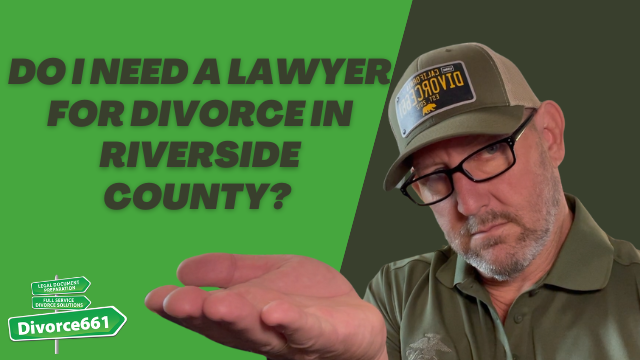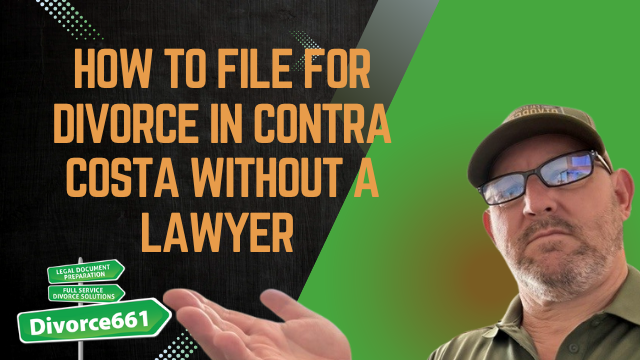Do I Need a Lawyer for Divorce in Riverside County? | Riverside Divorce
I’m Tim Blankenship with Divorce661. If you’re thinking about filing for divorce in Riverside County, you may be wondering whether you need to hire an attorney. The honest answer is: not always. California allows you to represent yourself, and many couples successfully complete an amicable divorce without a lawyer. But doing it yourself means handling important paperwork correctly — and that’s where most people get tripped up.
Can you represent yourself in Riverside County?
Yes. California law permits self-representation in family law matters. If both spouses are in agreement on the terms of the divorce — division of property, debts, spousal support, custody and visitation (when applicable) — an uncontested divorce can often be finalized without either party hiring an attorney.
What you still must do (even without a lawyer)
Even in an amicable, attorney-free divorce, there are specific steps required by the court. Missing or incorrectly completing any of these steps can cause rejections and delays.
- File the Petition and Summons: Initiating the case requires properly completed initial court forms.
- Serve your spouse: The other party must be served according to legal rules — correct method and proof of service are required.
- Complete and exchange financial disclosures: California requires both sides to disclose assets, debts, income, and expenses. These disclosures are mandatory.
- Submit a judgment package: The final paperwork (Judgment, Notice of Entry of Judgment, Declarations, and any settlement agreements) must meet Riverside County’s standards for acceptance.
Why accuracy matters
One small mistake can lead to rejection and delays.
Courts are strict about form and procedure. A missing signature, incomplete disclosure, or improper service can result in the court rejecting your filings. That prolongs the process, causes frustration, and may increase costs if you end up needing professional help to correct mistakes.
Common DIY mistakes to avoid
- Using outdated or incorrect forms.
- Improper service (wrong method or missing proof).
- Incomplete financial disclosures or missing supporting documents.
- Incorrectly completed judgment paperwork (formatting, signatures, dates).
- Failing to follow local Riverside County filing rules and requirements.
Real client example
We recently worked with a Riverside client who tried to do their divorce on their own. After several attempts, the court rejected their filings because of paperwork errors. They came to us, and we corrected the forms, completed the disclosures, and refiled everything properly. The result: the divorce was finalized — and no attorney was required.
How Divorce661 can help
At Divorce661 we specialize in attorney-free, full-service divorce solutions for amicable couples in California. Our goal is to give you the confidence that your paperwork is done right, without the higher cost of traditional legal fees.
- 100% done-for-you paperwork: We complete every required form accurately.
- Flat-fee pricing: No hourly billing surprises — predictable cost up front.
- Filings and disclosures handled: We prepare, file, and ensure local court standards are met.
- Final judgment assistance: We assemble and submit the judgment package so your case can be finalized.
When you should consider hiring an attorney
An attorney is advisable when your case includes:
- Contested issues (disputes over property, debts, custody, or support).
- Complex assets (business interests, significant investments, retirement accounts).
- Domestic violence, restraining orders, or safety concerns.
- Situations where future enforcement or modification is likely and legal strategy is needed.
If you have any of the above concerns, consult an attorney to protect your rights and interests.
Practical next steps
- Decide whether your divorce is truly amicable and suitable for a DIY approach.
- If you proceed without an attorney, make a checklist of required forms and deadlines.
- Consider professional document help if you want certainty without the attorney price tag.
- Keep organized records of service, disclosures, and all filed documents.
Get help without hiring an attorney
If you want to get divorced in Riverside County without a lawyer but still want expert help to avoid costly mistakes, we can assist. We handle the entire process for a flat fee and guide you through each step so your divorce is finalized the right way. Schedule a free consultation at divorce661.com to learn more and get started.
Conclusion
Do you need a lawyer for divorce in Riverside County? Not always. If your case is amicable and straightforward, self-representation is permissible. The key is to handle the paperwork correctly: file the petition and summons, serve your spouse properly, exchange required financial disclosures, and submit a court-approved judgment package. If you want professional help without attorney fees, consider a full-service, flat-fee solution that ensures accuracy and reduces delays.
For a free consultation and to find out how we can help, visit divorce661.com.










